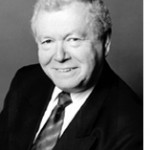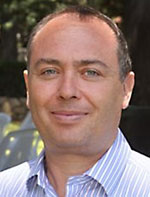By Donald H. Harrison

SAN DIEGO–Congregation Beth Israel was involved in a sacred trade this Shabbat weekend. It donated a Torah for a new synagogue in the Sha’ar Hanegev region of Israel, and Rabbi Michael Marmur, provost of the Hebrew Union College-Jewish Institute of Religion in Jerusalem, came here to lecture on Rabbi Abraham Joshua Heschel, Talmud, and the dissension between Reform and Orthodox in Israel.
Sha’ar Hanegev is the partnership region in Israel of the Jewish Federation of San Diego County. Located adjacent to Gaza, it is often in the news as an area that is subject to rocket attacks from Islamic hardliners across the border.
With 10 kibbutzim initially founded along the Socialist model, Sha’ar Hanegev is known as a secular community, rather than a religious one. However, many of its leaders, including Mayor Alon Schuster, believe that American-style Judaism–be it Reform, Conservative or Reconstructionist–could build a following among kibbutz residents, who are mostly unreached by Orthodox Judaism. So, in addition to having helped to build a rocket-proof school and educational center for Sha’ar Hanegev, San Diego County’s Jewish community also is helping to build a progressive brand of Judaism in that Israeli municipality as well.
During Erev Shabbat services on Friday evening, Feb. 7, Rabbi Michael Berk removed a Torah scroll from Beth Israel’s Aron Kodesh, in which several scrolls are housed, and carried it around the sanctuary of his Reform congregation so that congregants could symbolically touch their prayer books to it, and, in that way, say goodbye and wish that Torah scroll God speed on its journey to Israel.
Berk commented that whereas traditionally we think of Torah inspiration going from Israel to the Diaspora, in this case a Torah scroll was going from America to Israel — in essence symbolizing that Judaism today is more of a two-way street. He noted that during its recent celebration of its 150th anniversary, Beth Israel had commissioned the writing of a new Torah scroll. Congregants donated money for the privilege of helping a sofer to ink letters, words, phrases and weekly portions onto the parchment on which Torah is written.


Rabbi Michael Marmur, the featured speaker for Beth Israel’s Scholar-in-Residence weekend, provided another example of Torah learning being multi-directional. He grew up in England and later moved to Israel, where his lectures, delivered in a crisp British accent, are erudite yet not immune to the urge to include occasional puns. His father, Rabbi Dow Marmur, whose columns regularly are carried by San Diego Jewish World went from England to Canada, where he served as spiritual leader of Holy Blossom Temple in Toronto. Today, retired from the pulpit, Rabbi Dow Marmur divides his time between Canada and Israel.
The subject of several of Rabbi Michael Marmur’s talks at Beth Israel this weekend was the philosophy of Rabbi Abraham Joshua Heschel, who taught at Conservative Judaism’s Jewish Theological Seminary in New York City and was famed for having walked alongside the Rev. Martin Luther King in protest marches during the era of Civil Rights protests.
Marmur told the congregation that Heschel taught that spaces are not sacred in Judaism–not even the beautiful sanctuary and grounds of the Beth Israel campus at 9001 Towne Center Drive. What is sacred in Judaism, Heschel taught, is time. We know that Judaism teaches that Shabbat, the seventh day on which God rested from the work of Creation, is holy, but so too is time generally, because it is the province of the Divine, which man cannot control, not even momentarily, as he can control, divide, parcel out, conquer and defend spaces. Judaism teaches that time is fleeting and should be utilized wisely.
In the second part of his Friday evening lecture, Marmur told of a Reform synagogue, Beit Shmueli, in the central Israeli city of Raanana which was vandalized with literate, though highly objectionable, graffiti. Smeared across the synagogue’s walls were quotes from the Torah and from Talmud, which, in the context of the spray-painters (or “daubers” as Rabbi Marmur called them) cast the Reform movement as a hated enemy of authentic Judaism.
One quotation read: “None of them have a place in the World to Come, even though they are Jews. They are cut down and lost and doomed by the size of their wickedness, forever and ever… infidels, unbelievers in Torah … sinners in the many ways of public dissent …” Another quotation was “Do I not hate those who hate you, Lord, and abhor those who are in rebellion against you? I have nothing but hatred for them; I count them my enemies.”
The daubing came at a time of intra-religious tension in Israel, as that nation’s Supreme Court again upheld the right of the Israeli government to require Haredim to be conscripted for military service — a step that has been urged by secularists and members of progressive branches of Judaism who consider it unfair, and a burden on other Israelis, that the Haredim (ultra-Orthodox) are allowed to study in their Yeshivot instead of being required to serve in the military as other Israelis are. Also, recently in the news was a comment by Knesset Member David Rotem, for which he subsequently apologized, that Reform Judaism was a completely different (and inauthentic) religion that should be distinguished from Judaism.
Marmur, in his lecture, went on to relate a story from the Babylonian Talmud about Rabbi Pinhas ben Yair who was on a mission during Roman times to ransom some captives. He came across a river and ordered it to split its waters so that he could pass through. The river (yes, this one talked) argued that it had an assigned task to do, to flow, which it would surely fulfill, whereas the rabbi might not be successful in ransoming the captive whether the river split itself or not. Rabbi Pinhas threatened the river that its waters would dry up if it did not do as it was asked. So the river complied. Along came another man, who was carrying wheat for Passover (which would be ruined if it got wet)–and the rabbi had the river split for him too. And finally, there was a non-Jewish traveler, an Arab, for whom the rabbi again commanded the river to split. Once again the river complied.
For Israel today, taught Rabbi Marmur, there are three lessons to be drawn from the story. Like Rabbi Pinhas did, in ransoming the captive, Israel needs to protect the Jewish people. Like the man who was carrying wheat to be made into matzah for Passover, so too must Israel protect Judaism. And, as in the case of the non-Jew who also needed to cross the river, Israel must extend to other people the same blessings and respect it does to Jews.
Some Israelis focus only on the first mission of keeping fellow Jews safe by having a strong military, and taking steps to defend Israel against its many enemies throughout the Middle East. Another group, he said, focuses only on the second mission–keeping Judaism safe by making sure that food is kosher, that the Sabbath is not violated, and that the many laws of Torah are observed. Likewise, he said, there is a third group, that is preoccupied with the last component of the story, extending rights to the “other” by demanding the immediate acquiescence of Israel to the creation of an independent Palestinian state.
However, said Marmur, the Talmud really is teaching that Israel has a tripartite mission: to protect Jews, Judaism, and neighboring peoples. All three goals must be pursued simultaneously, however difficult that may be.
*
Harrison is editor of San Diego Jewish World. He may be contacted at donald.harrison@sdjewishworld.com